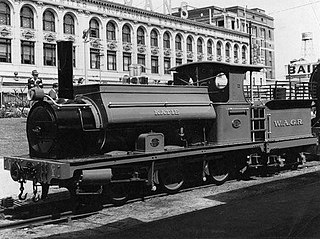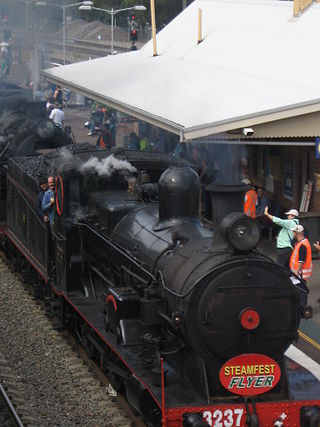
Bassendean is a north-eastern suburb of Perth, Western Australia. Its local government area is the Town of Bassendean.

The Eastern Railway is the main railway route between Fremantle and Northam in Western Australia. It opened in stages between 1881 and 1893. The line continues east to Kalgoorlie as the Eastern Goldfields Railway.

The Australind is a rural passenger train service in Western Australia operated by Transwa on the South Western Railway between Perth and Bunbury.

Western Australian Government Railways (WAGR) was the operator of railway services in the state of Western Australia between October 1890 and June 2003. Owned by the state government, it was renamed a number of times to reflect extra responsibility for tram and ferry operations that it assumed and later relinquished. Westrail was the trading name of WAGR from September 1975 until December 2000, when the WAGR's freight division and the Westrail name and logo were privatised. Its freight operations were privatised in December 2000 with the remaining passenger operations transferred to the Public Transport Authority in July 2003.

The NSW Rail Museum is the main railway museum in New South Wales, Australia. A division of Transport Heritage NSW, it was previously known as the New South Wales Rail Transport Museum (NSWRTM), Rail Heritage Centre and Trainworks.

The Midland Railway of Western Australia (MRWA) was a railway company that built and operated the Midland line in Western Australia. It was listed on the London Stock Exchange. Although having its headquarters in London, it had no association with the English Midland Railway.

UGL Rail is an Australian rail company specialising in building, maintaining and refurbishing diesel locomotives, diesel and electric multiple units and freight wagons. It is a subsidiary of UGL Limited and is based in Melbourne, with a staff of 1,200 across Australia and Asia. It operates factories in Broadmeadow, Maintrain Auburn, Spotswood and Bassendean. While it used to operate a factory in Taree, the plant was shut down and the equipment sold off.

Rail Heritage WA is the local trading name of the Australian Railway Historical Society Inc.

The WAGR X class is a now-withdrawn class of diesel locomotives built by Beyer, Peacock & Company and Metropolitan-Vickers, Bowesfield Works, Stockton-on-Tees for the Western Australian Government Railways (WAGR) between 1954 and 1956. Several members of the class have been preserved.

The Y class was a class of 18 diesel locomotives built by British Thomson-Houston and Clayton Equipment Company for the Western Australian Government Railways between 1953 and 1955. British Thomson-Houston supplied the electrical control equipment but the mechanical work, assembly and testing was carried out by Clayton Equipment Company at their premises in Hatton, Derbyshire. The locomotives carried separate builders plates for each company.

The WAGR Dd class was a class of 4-6-4T tank locomotive operated by the Western Australian Government Railways (WAGR) between 1946 and 1972.

The WAGR C Class was a class of steam locomotives built by Robert Stephenson and Company for the Western Australian Government Railways in 1880 to the same design as the NZR F class.

The Western Australian Government Railways operated many unique steam, diesel and electric locomotive classes. Often suffering from lack of available funds the WAGR locomotive fleet often consisted of locomotives far older than their expected operational life. Only one electric locomotive was operated by the government during the WAGR years.

The Hunter Valley Steamfest is one of the major events in the New South Wales steam locomotive season and also one of the major events held in Maitland, in the Hunter Region. Held over two days in April, it is usually attended by steam locomotives from the Canberra Railway Museum, NSW Rail Museum and East Coast Heritage Rail and railmotors from the Rail Motor Society.

The WAGR A/AA/AB classes are classes of diesel locomotives built by Clyde Engineering, Granville, New South Wales, Australia, for the Western Australian Government Railways (WAGR) between 1960 and 1969.

The MRWA E class was a single member class of diesel-hydraulic shunting (switching) locomotive built by Commonwealth Engineering, Bassendean, Western Australia, for the Midland Railway of Western Australia (MRWA) in 1957. The locomotive was later owned and operated by the MRWA's successor, the Western Australian Government Railways (WAGR).

The WAGR Q class was a two-member class of 4-6-0 steam locomotives operated by the Public Works Department (PWD) and later Western Australian Government Railways (WAGR) between 1928 and 1953.

The WAGR A class was a class of 2-6-0 steam locomotives designed by Beyer, Peacock & Co and operated by the Western Australian Government Railways (WAGR) between 1881 and 1955.

WAGR G class G233 Leschenault Lady is a preserved 2-6-0 steam locomotive, built in 1898 by James Martin & Co of Gawler, South Australia, for the Western Australian Government Railways (WAGR). It is the third oldest Australian-built steam locomotive still in operational order, after Victorian Railways Y class 112 and WAGR A class 15.




















